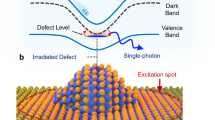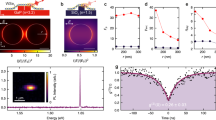Abstract
Solid-state single-quantum emitters are crucial resources for on-chip photonic quantum technologies and require efficient cavity–emitter coupling to realize quantum networks beyond the single-node level1,2. Monolayer WSe2, a transition metal dichalcogenide semiconductor, can host randomly located quantum emitters3,4,5,6, while nanobubbles7 as well as lithographically defined arrays of pillars in contact with the transition metal dichalcogenide act as spatially controlled stressors8,9. The induced strain can then create excitons at defined locations. This ability to create zero-dimensional (0D) excitons anywhere within a 2D material is promising for the development of scalable quantum technologies, but so far lacks mature cavity integration and suffers from low emitter quantum yields. Here we demonstrate a deterministic approach to achieve Purcell enhancement at lithographically defined locations using the sharp corners of a metal nanocube for both electric field enhancement and to deform a 2D material. This nanoplasmonic platform allows the study of the same quantum emitter before and after coupling. For a 3 × 4 array of quantum emitters we show Purcell factors of up to 551 (average of 181), single-photon emission rates of up to 42 MHz and a narrow exciton linewidth as low as 55 μeV. Furthermore, the use of flux-grown WSe2 increases the 0D exciton lifetimes to up to 14 ns and the cavity-enhanced quantum yields from an initial value of 1% to up to 65% (average 44%).
This is a preview of subscription content, access via your institution
Access options
Access Nature and 54 other Nature Portfolio journals
Get Nature+, our best-value online-access subscription
$29.99 / 30 days
cancel any time
Subscribe to this journal
Receive 12 print issues and online access
$259.00 per year
only $21.58 per issue
Buy this article
- Purchase on Springer Link
- Instant access to full article PDF
Prices may be subject to local taxes which are calculated during checkout




Similar content being viewed by others
Data availability
The data that support the plots within this paper and other findings of this study are available from the corresponding author upon reasonable request.
References
Senellart, P., Solomon, G. & White, A. High-performance semiconductor quantum-dot single-photon sources. Nat. Nanotech. 12, 1026–1039 (2017).
Aharonovich, I., Englund, D. & Toth, M. Solid-state single-photon emitters. Nat. Photon. 10, 631–641 (2016).
He, Y.-M. et al. Single quantum emitters in monolayer semiconductors. Nat. Nanotech. 10, 497–502 (2015).
Chakraborty, C., Kinnischtzke, L., Goodfellow, K. M., Beams, R. & Vamivakas, A. N. Voltage-controlled quantum light from an atomically thin semiconductor. Nat. Nanotech. 10, 507–511 (2015).
Koperski, M. et al. Single photon emitters in exfoliated WSe2 structures. Nat. Nanotech. 10, 503–506 (2015).
Srivastava, A. et al. Optically active quantum dots in monolayer WSe2. Nat. Nanotech. 10, 491–496 (2015).
Shepard, G. D. et al. Nanobubble induced formation of quantum emitters in monolayer semiconductors. 2D Mater. 4, 021019 (2017).
Palacios-Berraquero, C. et al. Large-scale quantum-emitter arrays in atomically thin semiconductors. Nat. Commun. 8, 15093 (2017).
Branny, A., Kumar, S., Proux, R. & Gerardot, B. D. Deterministic strain-induced arrays of quantum emitters in a two-dimensional semiconductor. Nat. Commun. 8, 15053 (2017).
Strauf, S. & Jahnke, F. Single quantum dot nanolaser. Laser Photon. Rev. 5, 607–633 (2011).
Sapienza, L., Davanço, M., Badolato, A. & Srinivasan, K. Nanoscale optical positioning of single quantum dots for bright and pure single-photon emission. Nat. Commun. 6, 7833 (2015).
Schnauber, P. et al. Deterministic integration of quantum dots into on-chip multimode interference beamsplitters using in situ electron beam lithography. Nano Lett. 18, 2336–2342 (2018).
Riedel, D. et al. Deterministic enhancement of coherent photon generation from a nitrogen-vacancy center in ultrapure diamond. Phys. Rev. X 7, 031040 (2017).
Zhang, J. L. et al. Strongly cavity-enhanced spontaneous emission from silicon-vacancy centers in diamond. Nano Lett. 18, 1360–1365 (2018).
Schneider, C. et al. Single photon emission from a site-controlled quantum dot–micropillar cavity system. Appl. Phys. Lett. 94, 111111 (2009).
Kaganskiy, A. et al. Micropillars with a controlled number of site-controlled quantum dots. Appl. Phys. Lett. 112, 071101 (2018).
Akselrod, G. M. et al. Probing the mechanisms of large Purcell enhancement in plasmonic nanoantennas. Nat. Photon. 8, 835–840 (2014).
Russell, K. J., Liu, T.-L., Cui, S. & Hu, E. L. Large spontaneous emission enhancement in plasmonic nanocavities. Nat. Photon. 6, 459–462 (2012).
Kongsuwan, N. et al. Suppressed quenching and strong-coupling of Purcell-enhanced single-molecule emission in plasmonic nanocavities. ACS Photon. 5, 186–191 (2017).
Luo, Y. et al. Purcell-enhanced quantum yield from carbon nanotube excitons coupled to plasmonic nanocavities. Nat. Commun. 8, 1413 (2017).
He, X. et al. Carbon nanotubes as emerging quantum-light sources. Nat. Mater. 17, 663–670 (2018).
Akselrod, G. M. et al. Leveraging nanocavity harmonics for control of optical processes in 2D semiconductors. Nano. Lett. 15, 3578–3584 (2015).
Hoang, T. B., Akselrod, G. M. & Mikkelsen, M. H. Ultrafast room-temperature single photon emission from quantum dots coupled to plasmonic nanocavities. Nano. Lett. 16, 270–275 (2015).
Tripathi, L. N. et al. Spontaneous emission enhancement in strain-induced WSe2 monolayer-based quantum light sources on metallic surfaces. ACS Photonics 5, 1919–1926 (2018).
Chikkaraddy, R. et al. Mapping nanoscale hotspots with single-molecule emitters assembled into plasmonic nanocavities using DNA origami. Nano. Lett. 18, 405–411 (2017).
Tran, T. T. et al. Deterministic coupling of quantum emitters in 2D materials to plasmonic nanocavity arrays. Nano. Lett. 17, 2634–2639 (2017).
Müller, M., Bounouar, S., Jöns, K. D., Glässl, M. & Michler, P. On-demand generation of indistinguishable polarization-entangled photon pairs. Nat. Photon. 8, 224–228 (2014).
Zhang, X.-X. et al. Magnetic brightening and control of dark excitons in monolayer WSe2. Nat. Nanotech. 12, 883–888 (2017).
Edelberg, D. et al. Hundredfold enhancement of light emission via defect control in monolayer transition-metal dichalcogenides. Preprint at https://arXiv.org/abs/1805.00127 (2018).
Ajayi, O. A. et al. Approaching the intrinsic photoluminescence linewidth in transition metal dichalcogenide monolayers. 2D Mater. 4, 031011 (2017).
Ross, J. S. et al. Electrically tunable excitonic light-emitting diodes based on monolayer WSe2 p–n junctions. Nat. Nanotech. 9, 268–272 (2014).
Baugher, B. W. H., Churchill, H. O. H., Yang, Y. & Jarillo-Herrero, P. Optoelectronic devices based on electrically tunable p–n diodes in a monolayer dichalcogenide. Nat. Nanotech. 9, 262–267 (2014).
Pospischil, A., Furchi, M. M. & Mueller, T. Solar-energy conversion and light emission in an atomic monolayer p–n diode. Nat. Nanotech. 9, 257–261 (2014).
Acknowledgements
The authors thank M. Begliarbekov for supporting the development of the electron-beam lithography process at the City University of New York Advanced Science Research Center (ASRC) nanofabrication facility, and L. Dai for help with designing Fig. 1a. The authors acknowledge financial support to S.S. from the National Science Foundation (NSF) under awards DMR-1506711 and DMR-1809235 and to J.C.H. under awards DMR-1507423 and DMR-1809361. S.S. acknowledges financial support for the attoDRY1100 under NSF award ECCS-MRI-1531237.
Author information
Authors and Affiliations
Contributions
S.S. and Y.L. designed the experiment. Y.L fabricated the plasmonic chips. G.D.S. and J.V.A. performed the layer transfer procedures. Y.L. and G.D.S. performed the optical experiments and analysed the data. D.A.R. and B.K. carried out the flux growth. K.B. and J.C.H. supervised the growth. S.S., G.D.S. and Y.L. co-wrote the paper. All authors discussed the results and commented on the manuscript.
Corresponding author
Ethics declarations
Competing interests
The authors declare no competing interests.
Additional information
Publisher’s note: Springer Nature remains neutral with regard to jurisdictional claims in published maps and institutional affiliations.
Supplementary information
Supplementary Information
Supplementary Figures 1–9 and Supplementary Tables 1–2
Rights and permissions
About this article
Cite this article
Luo, Y., Shepard, G.D., Ardelean, J.V. et al. Deterministic coupling of site-controlled quantum emitters in monolayer WSe2 to plasmonic nanocavities. Nature Nanotech 13, 1137–1142 (2018). https://doi.org/10.1038/s41565-018-0275-z
Received:
Accepted:
Published:
Issue Date:
DOI: https://doi.org/10.1038/s41565-018-0275-z
This article is cited by
-
Programmable nanowrinkle-induced room-temperature exciton localization in monolayer WSe2
Nature Communications (2024)
-
Mechanically driven assembly of biomimetic 2D-material microtextures with bioinspired multifunctionality
Nano Research (2024)
-
The Roadmap of 2D Materials and Devices Toward Chips
Nano-Micro Letters (2024)
-
Chemomechanical modification of quantum emission in monolayer WSe2
Nature Communications (2023)
-
Radiative suppression of exciton–exciton annihilation in a two-dimensional semiconductor
Light: Science & Applications (2023)



